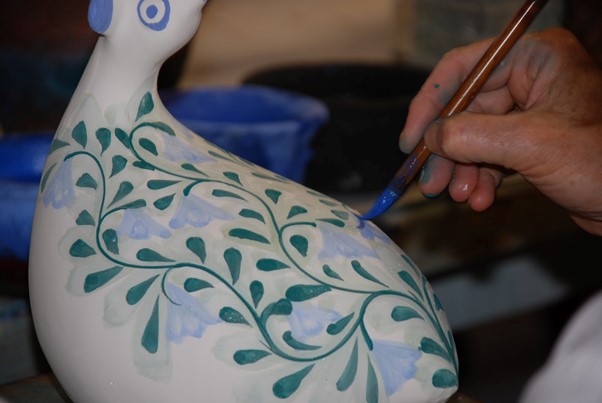Pottery is a mesmerizing and time-consuming task. It requires great patience from the beginning till the end. There are various techniques involved in the process. One such important technique being used by potters for a long time is the pottery slipping process. This slurry-like mixture is made up of clay particles mixed in water.
As a pottery artisan, you must know the basics of slipping techniques to achieve perfection. By mastering these important techniques, you can easily apply intricate designs or join the pieces together. But there is one tip that you should stick by. Most beginners assume that slipping is a technique mostly used to join pieces, but it can be versatile when used correctly.
So, let us take a look at what it is.
Using Slip for Pottery Decoration
Slipping is extensively used for decoration, especially by potters that love to experiment with new techniques. In this process, the content of the clay in the slip is high. It is applied using an applicator and used to design beautiful patterns. This process takes place when the item becomes leather hard. The slip is then squeezed or dribbled upon the item. Generally, potters use an applicator called a “bulb syringe.” With the right kind of bulb applicator like the COMIART Silicone Ball, you can create some amazing designs with complete precision. This applicator is ideal for slip trailing and other decorative uses.

But, it is very important to maintain the right consistency of water and clay in the slip. If the consistency is thick, then the designs will have a sharp end. Hence, to avoid this, you need to use a thinner slip that settles on the item properly. Along with that, you can also use clear glazes after this process for better detailing.
You can also add colors to your slip and make colorful designs using the blood syringe. It is similar to glaze trailing. But when the design is applied, it adds a raised surface and adds more texture to the material.
Basic Information for Slip Trailing
- Slips can mostly flatten and don’t move during firing
- When you mix a color with the clay, the slip will remain in its place
- When it is fired properly, it engulfs the item. Also, it cannot be removed even when it is scraped
Steps for Slip Trailing
If you are a beginner and going to work upon slip trailing, then these tips will be beneficial-
- Properly select your slipping tools and materials
- Understand the different techniques of slip trailing
- Practice your idea on a slab before using the bulb syringe
- Then, go ahead and try upon pots and other ceramics.
Other Important Tips for Slipping Your Pottery
There are various types of slipping that you can apply for pottery. Read below to learn more.
Adding colors to the slip
A slip is basically a mixture of water and clay particles similar to a slurry. There are various uses of slipping, such as decorating, protecting, joining, etc. In addition, it is used for adding color or texture to the pottery item.
You can add different colors to the slipping mixture. Some of the ingredients for slipping are nepheline syenite, kaolin, and flint. The slip remains liquid when you apply. But, after drying, it hardens and adds a smooth texture. Furthermore, dry slips are also available that you can use effectively. You can also use “Engobe,” which is similar to slipping. With different layers of slips, you can easily create beautiful designs. Hence, it is one of the useful methods when slipping in pottery.
Use it as Glue to stick other potteries
Secondly, another use of slip is using it like glue. You can easily make a slip mixture with the scraps of potteries. Just mix it with water until it softens. Then mix it well to remove any lumps. Finally, usually, you can apply it where it is required and join other parts.
This process is also known as slip-slurry. It will help you to add different textures and shapes to the item. You can then add designs accordingly after finalizing the shape when the slip dries out. Furthermore, you can add colors and give it a unique design.
How to use the Slip casting method?
Another method for slipping is called “slip casting.” In this process, the consistency of the slip is similar to buttermilk. First, the sip is poured inside a mold which absorbs the liquid. Then clay shrinks but still retains the shape.
You need to keep the clay inside the mold overnight to dry properly. It is an effective process for making several items of the same shape and size. After that, other processes such as cleansing and firing are done. Thus, slip casting is an important process to shape the item.
Can you use the flashing process?
The flashing effect helps give the best organic effect on the item. It happens due to the different styles of fire. The effects are natural when soda vapors, wood ash, etc., contact with the flame. Hence, therefore this process makes every item with a unique decorative design.
The slips used for flashing have a thin consistency. To achieve the unique design, alumina reacts, soda and ash are added to the slip. Thus, the minerals are released during the flashing, and it gives a unique design to the pot.
As a result, you will get the best organic and natural glaze in your pot. Also, the pots will get natural color with an artistic touch.
Always use the right clay
Clay is an integral part of pottery. Then during slipping your pottery, it is important to choose the right clay. If the clay feels like sandpaper, then it is not the right clay. Thus, the clay should be smooth and strong. This will help you to get the best results.
You can also use underglaze for more fine and intricate results. Furthermore, engobes with a gooey texture can also enhance the images before the firing process. Also, you must use a mesh to refine the slip to remove any impurities and smooth texture.
Beginning with practice
To begin slipping, it is important to finalize the design. For that, you must practice the design beforehand for better understanding. In this way, you will learn about the consistency of the slip. For example, if it is watery, you can adjust it accordingly. Also, you can understand the motions of your hands properly.
For better results, you can use Xiem Lightweight Precision Applicator. It is ideal for slip trailing and designing pottery.
These are some types of slipping techniques and their process
Types of Slips |
Process |
| For Casting Moulds | Water is added. Also, 2% of sodium silicate, soda ash is added |
| For decorations | Epsom salt is added to thicken and smooth the slip. It is applied upon leather hard pots to add intricate details |
| Colored Slips | It is done during the hard leather stage |
| Marble Effect by Slipping | Roll clay and then cover it with a layer of slip. Then the colors are added on the top with eye-droppers or pipettes |
| Slip Trailing | It is available in a precision bottle. You can easily remove the error and start again |
| Sgraffito | The slip is added to a clay body. After drying, you can scratch the surface to carve out the design |
Conclusion
With these tips in mind, you can craft some amazing pieces for your pottery collection. However, if you are a beginner, you will require practice. With different techniques and using the right method, you can easily master this art. You also need to have the patience to learn every detail of this craft, especially when starting as a pottery artist. Always practice caution and remember that sky is the limit when experimenting with techniques and designs.







